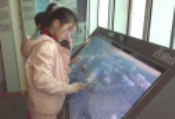By Kalwinder KaurSep 17 2012
Zytronic’s patented Projected Capacitive Technology (PCT) for touchscreen systems for demanding applications and environments has been successful. Zytronic has achieved another design win in a prestigious public deployment, with dual-touch capable ZXY100 controller technology and customized 46” versions of its ZYBRID touch sensor, employed by Taiwanese specialist systems integrator VitalTouch for adoption in Taipei 101 skyscraper.
 Scalability of ZYBRID® touchscreens
Scalability of ZYBRID® touchscreens
VitalTouch-created tourist guide system is based on the tower’s 89th floor. PCT touch sensors have been built within twin large screen LCDs, through which visitors can be informed about the city similar to that seen from the observation deck. The touch technology-based dual-touch functionality supports interaction of visitors with the large screen design combined with varied optional features for providing information on Taiwanese capital and its people.
The 509 m tall Taipei 101 marked as world’s tallest building until 2010, now stands as an iconic representation in Asia. Featured with extensive footfall, the touchscreen’s efficiency has to be validated to avoid risk of downtime resulting from maintenance or repair. PCT touch sensors have been optimized for such applications with seamless operation.
The PCT sensor structure is created from a matrix of micro-fine copper capacitors implanted within a laminated substrate for further positioning behind a thick protective overlay for challenging applications. Zytronic’s ZXY100 controller has been added to allow concurrent detection of two independent touch points on large form factor displays, ensuring precise, excellent levels of touch sensitivity.
Four units overlooking the west, east, north and south sides from the observation deck have been installed. The touchscreens therefore need to adjust with extreme temperatures and potentially adverse weather conditions. Each unit includes two 40” displays affixed to form an extensive landscape view screen. Zytronic partnered with VitalTouch to modify the sensor designs for reducing the borders, promoting improved touch performance via the 8 mm thick glass overlay.
Disclaimer: The views expressed here are those of the author expressed in their private capacity and do not necessarily represent the views of AZoM.com Limited T/A AZoNetwork the owner and operator of this website. This disclaimer forms part of the Terms and conditions of use of this website.